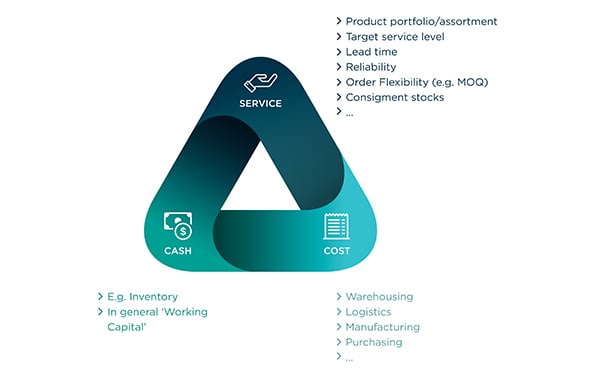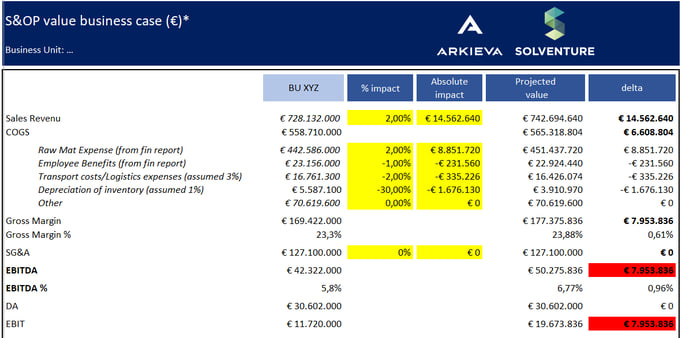
Supply chain management is becoming increasingly complex nowadays due to factors including globalization, the rapid pace of market developments, technology, the growing number of products and customers, and the increasing diversity of customer wants and needs. In these challenging circumstances, many of our customers want to boost their business performance to improve service levels, cut costs and increase cash influx. But the more complex their supply chain becomes, the more important it is to manage it effectively through supply chain planning.
In this blog we will discuss how S&OP, supply chain planning and, more specifically, Advanced Planning and Scheduling (APS) systems can support your business performance and give your organization a relatively quick payback in comparison with the planning functionality of a traditional ERP, at only half of the cost.
From our experience, the road to business performance improvement should always start with a clear view on the balance between your organization’s service level, costs and cash. This triangle is the framework we start from at Solventure when we discuss possible planning solutions for the business challenges a client may have. It captures the struggle we regularly see in many supply chain departments between improving service, minimizing cost and reducing inventory (working capital).

Balancing this triangle is important because each side has influence on the others. For instance, improved services can lead to more sales, higher sales lead to lower inventory and a decreased inventory leads to less storage costs. If you combine these elements you end up at the heart of the triangle: Return On Capital Employed, or ROCE. This financial metric depicts the margin (service minus costs) over the invested capital. Supply Chain Planning directly touches the heart of this triangle, and consequentially also the heart of value generation. We use ROCE to measure the value of an S&OP improvement and communicate it towards financial decision-makers in a company.
To dive deeper into the Supply Chain Triangle and other inspiring S&OP insights, we recommend reading Bram Desmet’s book “Supply Chain Strategy and Financial Metrics”.
Research by Supply Chain Insights has shown that “the Return on Investment (ROI) of Supply Chain Planning is an impressive 7-12 months”. However, this average payback period is only possible under the right circumstances, “when the organization is in place, the change management issues are tackled, the right leadership support is present, and technologies are deployed correctly”. Thus, leadership buy-in, engaging change management and best-of-breed technology tools are equally important, even though the tooling often catches all the attention. That is why Solventure created a 7-step approach to drive sustainable change and value through S&OP, which gives a holistic perspective of the importance of people, processes, tools and analytics in S&OP implementation.
The most striking finding from this study is the payback period for real S&OP software. At an average of just 7 months, the ROI is very short. In comparison, it takes an average of 13 months to earn back the investment in an ERP-based planning module. Moreover, ERP systems are great for analyzing historical data, but less suitable for forecasting and demand planning at a tactical level. Specialized software is needed to manage a supply chain effectively. In the Supply Chain report, Lora Cecere calls it ‘best of breed’ software. You can read more about this topic in our blog on the added value of S&OP software.
To learn the full effect of an improved S&OP on your business, Solventure offers you a detailed business template that helps you make realistic and personalized assumptions of the possible topline impact on your service levels, costs, and cash, and the eventual bottom-line results. This template is based on years of S&OP implementation data and experience and gives you the ability to predict the ROI of different S&OP solutions for your business. Taking these assumptions into account, together with the project costs, we usually end up with a 6 to 12 months payback period for the APS implementation.

This concrete, industry agnostic, model allows us to translate our theoretical supply chain learnings into clear and unique business KPIs, which can be easily understood by your financial team, who has to clear your S&OP project. They can see how certain investments into an improved S&OP trickle down to the rest of your business over a time span of 1 to 3 years. Afterwards we can help you compare these numbers to other benchmarks in your sector to arrive at a realistic target ROI.
If you would like to find out what the ROI of an APS solution would be for your company, we’ll be happy to assist you. Schedule a free 30-minute call with us, and we’ll guide you through our S&OP business case template.
These Stories on Executive S&OP